You are using an out of date browser. It may not display this or other websites correctly.
You should upgrade or use an alternative browser.
You should upgrade or use an alternative browser.
xDuoo Poke II
- Added by NymPHONOmaniac
- Create date
JQuB3
New Head-Fier
Pros: - Good balance of fun and analytical sound.
- DAP like SQ and power.
- Sleek, Stylish and well built.
- In Built mic.
- Great battery life.
- DAP like SQ and power.
- Sleek, Stylish and well built.
- In Built mic.
- Great battery life.
Cons: - Limited input options (USB and BT only)
- Bare minimal User EQ customization.
- Bare minimal User EQ customization.
Before I start, I'd like to point out the obvious. The Poke II doesn't have the versatility of XD05-BAL. In terms of power too, it doesn't offer as much as the XD05-BAL. Therefore, if you're looking for a portable dacamp with BT capability that offers the flexibility of being used as an integrated dacamp, or just a DAC (BT in, USB in/ SPDIF in, Line out) or as a just as an Amp (Line in), and are ok with carrying a larger and bulkier unit, the XD05-BAL, at just 40 USD extra, might be a better option.

However if you're looking for something lightweight and easily pocketable, albeit with limited IO options (BT in, USB in, 3.5mm SE PO and 4.4mm BAL PO) the Poke II is a great option. The major difference between other BT dacamps such as FiiO BTR3K, BTR5, BTR7 or Shanling UP4, UP5 is the massive battery (4000 mAH) and power output. The smaller bt dacamps are usually in the 160mW to 320 mW(32 ohm BAL) range, while the Poke II offers 700mW, which is more or less similar to a DAP (if not a tad bit more).
Speaking of aesthetics, the Poke II definitely looks cool and stands out from the regular grey/ black / silver colored gear we usually get. With the "Life's a Struggle" tagline, it definitely grabs attention. Perhaps the Pokémon licensing is a factor that pushes the cost up to a relatively high 390 USD. Although I bought the leather case along with the Poke II, I like the looks of the device and prefer using it without the cover.

Sound wise, this is quite different from the XD05+ (AKM) and XD05-BAL (ESS). The Poke II features Dual CS43198 dac chips. I've recently fallen in love with Cirius Logic DACs cuz they seem to have a good balance of musicality and technicality that IMO places them in between the typical AKM velvet sound and the ESS sound. In short, one can expect some good bass slams along with a fair bit of sparkle and energy.
The Poke II includes EQ, gain and filter options. There are 2 filter options, 1 is a tad bit lean, with refined treble, while the other is a little warm with more weight in the mids and better bass presence. Personally I prefer using the 2nd filter while listening to music. EQ options are mostly pre-configured, although one can personalize the bass and treble response in the "Tone" EQ mode. This is perhaps the only gripe I have with the Poke II. IMO they could have, at the very least, given us a 3 band equalizer. IMO, the current solution is close to useless in terms of custom EQ.

Being a user experience designer by profession, I'm habituated to listening to music while I work, as it helps maintain the flow and keeps me focused. However, calls and meetings are pretty much unavoidable in the post pandemic era. Therefore, I like the fact that xDuoo was thoughtful enough to place a mic on the Poke II, which makes it convenient to answer calls or join meetings without having to remove my IEMs. The mic seems to pick up my voice pretty clearly when the unit is placed in my shirt pocket, or my work desk.
I also tried the Poke II with my PS4 and I was quite impressed with the setup. (PS4 <-> BTA30 Pro <-> Poke II). Playing a round of Uncharted online was quite a lot of fun, especially in the Movie EQ mode, thanks to the enhanced dynamics and distortion free explosions and rumbles.

Lastly, the Poke II has an option to charge other devices thanks to the 4000 mah battery. This is quite useful given how quickly the battery on the DualShock4 controller loses charge.
All in all, I'm quite happy with my purchase of the Poke II, which will be replacing my 2 year old FiiO Q5s. If only the Poke II had some analog input options, it would have been an excellent VFM portable dacamp.

However if you're looking for something lightweight and easily pocketable, albeit with limited IO options (BT in, USB in, 3.5mm SE PO and 4.4mm BAL PO) the Poke II is a great option. The major difference between other BT dacamps such as FiiO BTR3K, BTR5, BTR7 or Shanling UP4, UP5 is the massive battery (4000 mAH) and power output. The smaller bt dacamps are usually in the 160mW to 320 mW(32 ohm BAL) range, while the Poke II offers 700mW, which is more or less similar to a DAP (if not a tad bit more).
Speaking of aesthetics, the Poke II definitely looks cool and stands out from the regular grey/ black / silver colored gear we usually get. With the "Life's a Struggle" tagline, it definitely grabs attention. Perhaps the Pokémon licensing is a factor that pushes the cost up to a relatively high 390 USD. Although I bought the leather case along with the Poke II, I like the looks of the device and prefer using it without the cover.

Sound wise, this is quite different from the XD05+ (AKM) and XD05-BAL (ESS). The Poke II features Dual CS43198 dac chips. I've recently fallen in love with Cirius Logic DACs cuz they seem to have a good balance of musicality and technicality that IMO places them in between the typical AKM velvet sound and the ESS sound. In short, one can expect some good bass slams along with a fair bit of sparkle and energy.
The Poke II includes EQ, gain and filter options. There are 2 filter options, 1 is a tad bit lean, with refined treble, while the other is a little warm with more weight in the mids and better bass presence. Personally I prefer using the 2nd filter while listening to music. EQ options are mostly pre-configured, although one can personalize the bass and treble response in the "Tone" EQ mode. This is perhaps the only gripe I have with the Poke II. IMO they could have, at the very least, given us a 3 band equalizer. IMO, the current solution is close to useless in terms of custom EQ.

Being a user experience designer by profession, I'm habituated to listening to music while I work, as it helps maintain the flow and keeps me focused. However, calls and meetings are pretty much unavoidable in the post pandemic era. Therefore, I like the fact that xDuoo was thoughtful enough to place a mic on the Poke II, which makes it convenient to answer calls or join meetings without having to remove my IEMs. The mic seems to pick up my voice pretty clearly when the unit is placed in my shirt pocket, or my work desk.
I also tried the Poke II with my PS4 and I was quite impressed with the setup. (PS4 <-> BTA30 Pro <-> Poke II). Playing a round of Uncharted online was quite a lot of fun, especially in the Movie EQ mode, thanks to the enhanced dynamics and distortion free explosions and rumbles.

Lastly, the Poke II has an option to charge other devices thanks to the 4000 mah battery. This is quite useful given how quickly the battery on the DualShock4 controller loses charge.
All in all, I'm quite happy with my purchase of the Poke II, which will be replacing my 2 year old FiiO Q5s. If only the Poke II had some analog input options, it would have been an excellent VFM portable dacamp.
Attachments
NymPHONOmaniac
Headphoneus Supremus
Pros: -True high fidelity sound with insane resolution
-clean crisp sound with effortlesss detailing
-excellent imaging and transparency
-complete black noise floor (USB, not Bluetooth way)
-mature neutral tonality
-speedy and tight attack control-sustain-release
-will reveal every micro details without feeling agressive bright or harsh
-delicate brilliant treble
-tone EQ
-lot of features and buton control
-long battery life
-powerfull amping in small portable size
-great bluetooth sound quality (Ldac)
-quality construction that feel very sturdy
-clean crisp sound with effortlesss detailing
-excellent imaging and transparency
-complete black noise floor (USB, not Bluetooth way)
-mature neutral tonality
-speedy and tight attack control-sustain-release
-will reveal every micro details without feeling agressive bright or harsh
-delicate brilliant treble
-tone EQ
-lot of features and buton control
-long battery life
-powerfull amping in small portable size
-great bluetooth sound quality (Ldac)
-quality construction that feel very sturdy
Cons: -Audacious design look that might not please everyone
-cold neutral sound that might lack musicality for some
-lean dynamic that lack weight note and bass impact
-thin timbre
-slow volume control step
-instable Bluetooth connectivity at long distance
-long to charge without fast charger
-a bit on the expensive side for a Xduoo offering
-tempered glass=finger print magnet
-cold neutral sound that might lack musicality for some
-lean dynamic that lack weight note and bass impact
-thin timbre
-slow volume control step
-instable Bluetooth connectivity at long distance
-long to charge without fast charger
-a bit on the expensive side for a Xduoo offering
-tempered glass=finger print magnet

TONALITY: 7.8/10
TECHNICALITIES: 9/10
AMPING QUALITY-POWER: 8.5/10
BATTERY LIFE: 8.5/10
CONSTRUCTION: 9/10
DESIGN: 8/10
SOUND VALUE: 8/10
XDUOO is a Chinese company with about 20 years of experience in creating DAP and DAC-AMP. Having tested a good part of its very large catalog of products, with prices ranged between $50 and $500, today I’m going to test their latest addition, a portable Bluetooth DAC-AMP named Xduoo Poke II.
The Poke II sells for $390, it uses a dual high-end cirrus CS43198 DAC in tandem with powerful current amplification, it is a balanced DAC-AMP through the use of one DAC per channel. The Poke II is an improved version of the first Poke, another bluetooth DAC-AMP with a single AK4490 DAC and half the amplification power.
On paper, the Poke II promises top-notch performance with 119db Signal-to-noise and 106db Crosstalk, but let’s see how that translates to audio performance and musicality in this review.
CONSTRUCTION
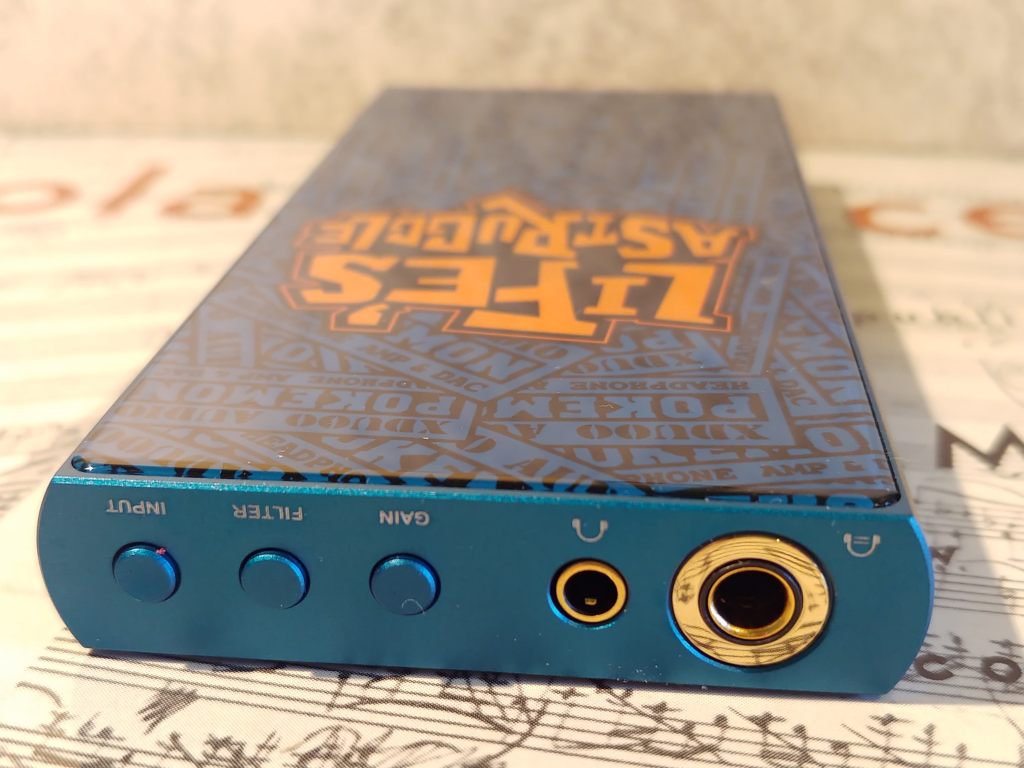
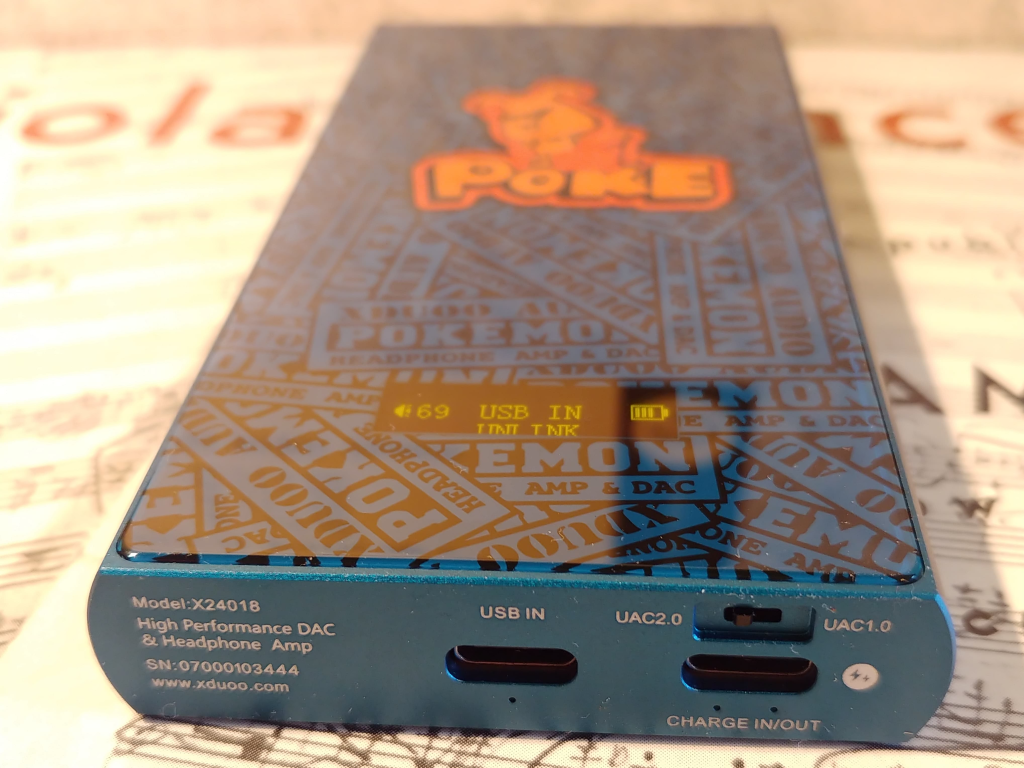
The Xduoo Poke II is quite small for its functionality and power output. It measures barely 12cmx6cmx1.5cm with a fairly substantial weight of 200 grams. Its construction is all blue brushed metal with a tempered glass top and back. A small screen with OLED brightness tells us all the necessary information (volume, gain, input, sample rate, EQ, battery power). All the buttons are made of metal, and it seems that all the sockets including the USB-C ports are gold-plated too. The standard 3.5mm and balanced 4.4mm jacks are of very high quality. The build is excellent, with no sharp or poorly polished corners.
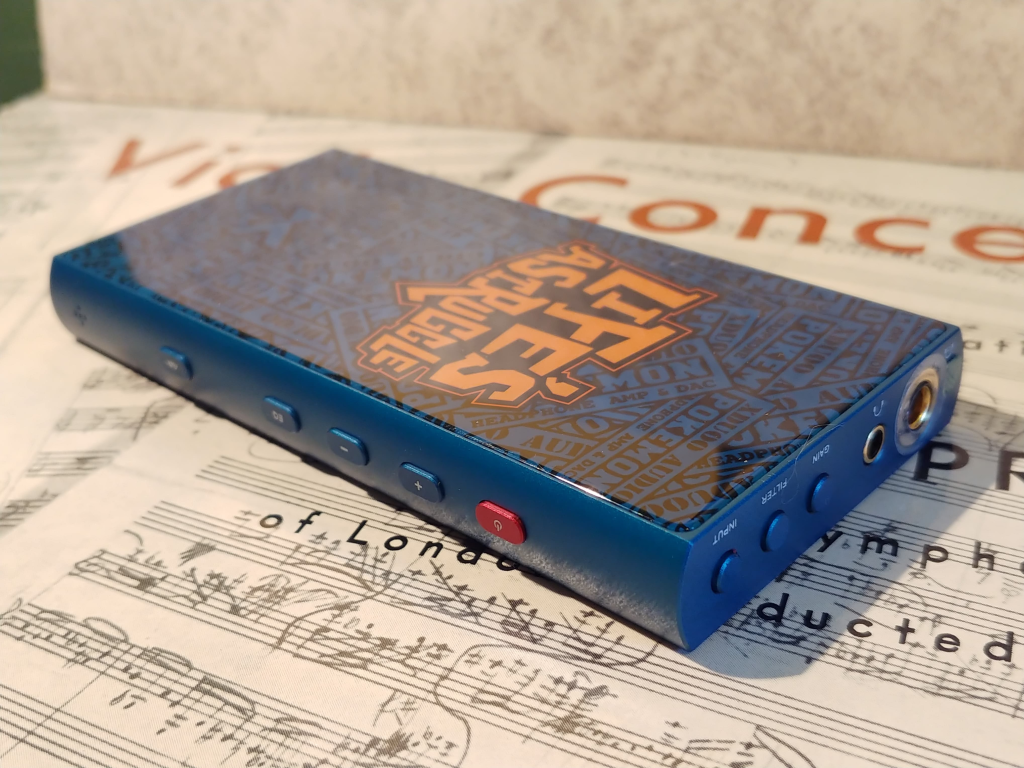
Now, when it comes to looks, Xduoo is aiming for a younger, cooler crowd with its Poke series, named…as a tribute to Pokemon, it seems. Let’s say that the phrase on the back of the Poke ”Life’s a Struggle” is quite surprising, and we scratch our heads to see a connection with the passion for music. Is music an escape from a dystopian reality that we have to fight against? Is this a nod to the last 2 years of the pandemic which were nerve-wracking for 99% of humans? It’s hard to know, because the general appearance with its mascot Rabbit with smoked glasses seems to evoke good-natured idleness, in short, anything but headache. So, yes I believe that the choice of decorative aesthetics of this DAC-AMP is quite questionable and that people over 40 could be embarrassed to have an object with the word pokemon written everywhere in addition to a rabbit orange and a sentence evoking the crisis of adolescence. But hey, I’m 38 years old and I’m open-minded, so it doesn’t bother me and my 5-year-old son finds this orange rabbit very nice! The irony in all this is that this Poke II offers anything but an immature, fun and colorful tone, as its bold look might suggest.

In term of ACCESSORIES, Xduoo rarely disappoint and indeed we have a generous package that include 2 USB-C to USB-C cable, the orange one being of great quality with tight connector. 1 USB-C to lightning cable and 1 USB-C to USB adapter. As well, it include the very practical Xduoo X-SK1 ”High-tech Nano biological Magic sticker” which indeed do magic to old phone and dac-amp togheter securly. You can even clean it and it will not loose its stickyness. All in all, while I would have appreciated a 2.5mm to 4.4mm adapter too, the whole package is very good and will cover most needs so the consumers isn’t stock to buy a USB-C to lightning cable if he have an Iphone for example.
FEATURES
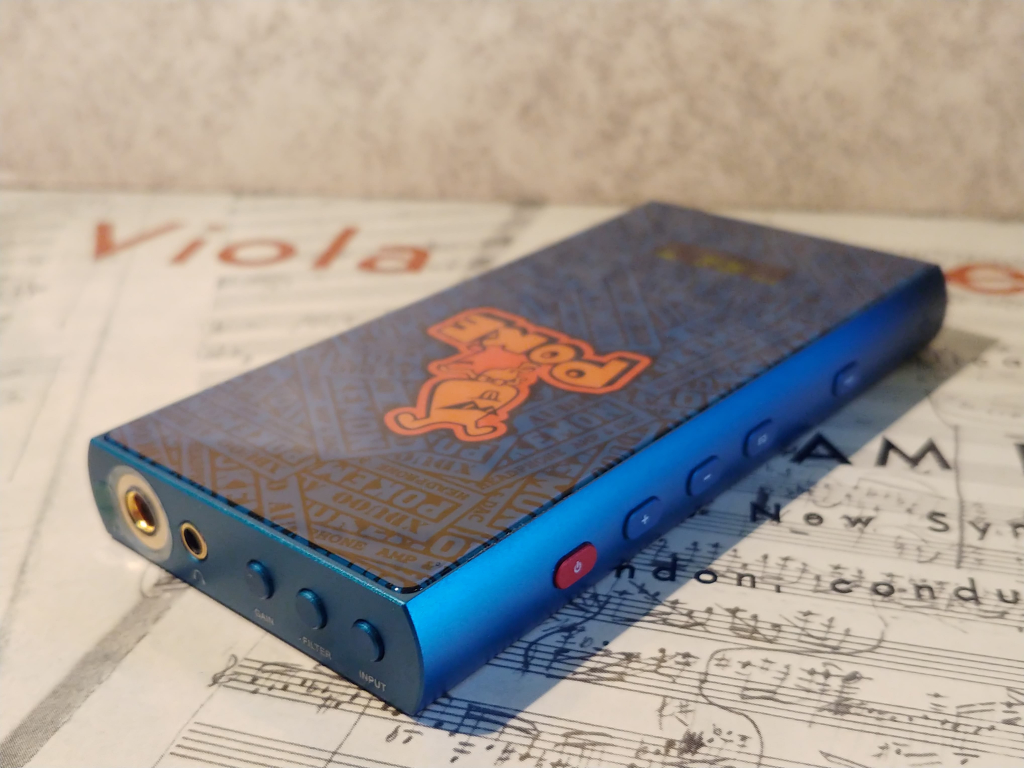
The POKE II is a beast of versatility in terms of control, options and connectivity.
-It has two USB-C sockets. One (USB IN) for USB audio reception, which can be compatible with UAC1.0 or 2.0 sockets, selectable by a switch located above the second USB-C socket, which has a double function because it can receive and deliver current, so be used to charge a phone or other electronic product in case of emergency. Note that we can also charge the Poke II while we use it, without affecting its functionality or sound.
-It has 8 metal buttons.
On its front we find the GAIN button with the option of no gain or high gain (+10db).
The FILTERS button, offering 2 types of digital signature, one sharper brighter, the other softer with hint of bass warmth.
The INPUT button, to select USB or Bluetooth reception. Also, when you press this button for 3 seconds, the LOCK mode comes on board, which is very welcome to block any involuntary button press.
-The other 5 buttons are on the left side.
The red button is for turning the device on and off, having to keep it pressed for 5 seconds is a bit long in my opinion.
Then we have the VOLUME CONTROL buttons, again a bit of a problem here, as holding down is supposed to continuously move up or down the 100 volume steps, but it’s slower than pressing the keys quickly, so it’s very slow.
Below we have the EQ button. It has 5 sound signature choices: Tone, Movie, Game, Pop and None. Interestingly, we can calibrate the high and low frequency boost with -10db to +10db clearance. To do this, simply press the EQ button a second time in Tone mode and use the volume buttons to calibrate as we wish.
And finally, the last button is used to play or stop music in Bluetooth mode with a quick press, or force disconnection with a sustained press.
MORE ON THE EQ
Although I’m not a big fan of the 3 presets which include GAME (clearer, more analytical and aggressive), MOVIE (more open and bassy, home theater style) and POP (more V-shape), the TONE option is very interesting with a result immediate on the tonal balance. So if you want to turn say a UM MEXT into a basshead monster, add 10db of bass and 2db of treble and the sub bass will rock your sock off. This EQ, although minimalist, still allows a boost or taming range of 20db and this intuitive simplicity is very practical in the end. The boost is in the 50-150hz section I would say for the bass and 6khz-9khz for the highs, so it’s not really possible to add extra sparkle-brilliance, it’s mostly abrasiveness and magnification of texture. Still, it adds energy and bite to the attack, which is welcome because for brilliance, the Poke already delivers that fully.
USB CONNECTION is plug and play, and compatible with audio coded up to PCM 32bit/384khz and DSD256, it is as well compatible with MQA, using app like UAPP or Hiby Music player.Connection is stable, I didnt encounter any jitter or sound cutting, everything work really smooth and clean.
AMPLIFICATION
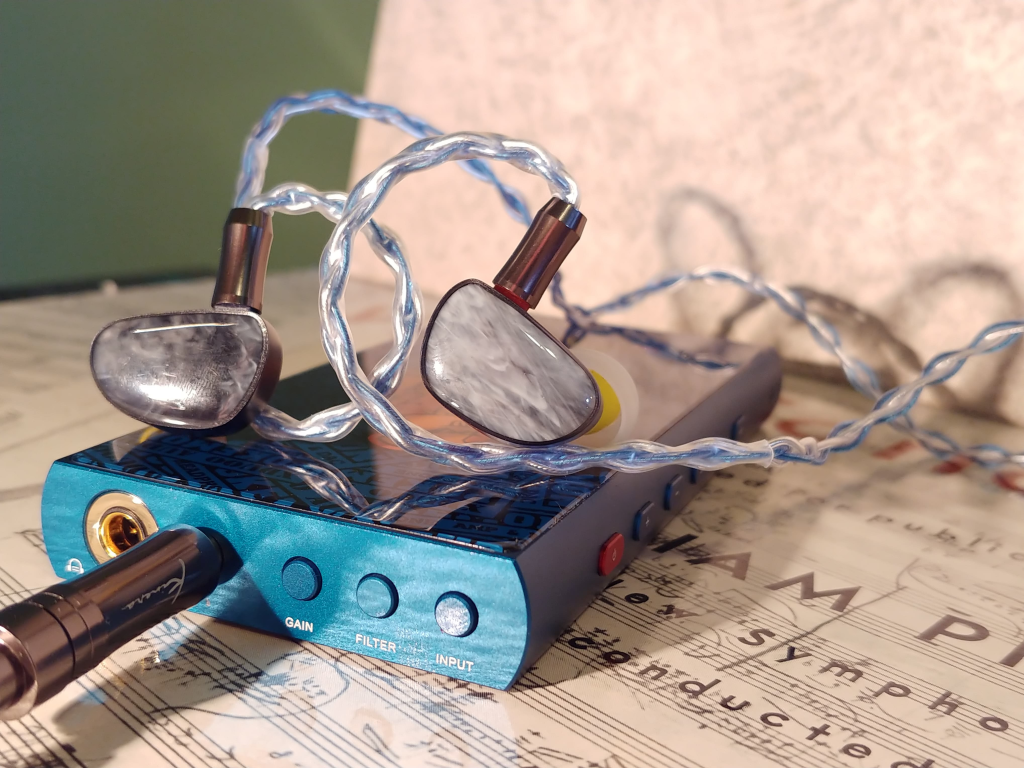
The standard 3.5 output delivers 340mw@32 ohm and the balanced 4.4 delivers a whopping 700mw@32ohm, which is certainly impressive and more than enough to drive 90% of IEMs, headphones and earbuds to their full potential. Still, this type of current amplification is very linear, and could give the impression of playing less loudly, a bit like THX amplifiers. It’s so flat, clean, transparent and low in harmonic distortion that it might surprise those used to solid state. So powerful but not garish or fleshy in its rendering, very digital and modern, without grain or background noise. Ultra clean and linear, ultra extended in its frequencies also although more energetic in the high than dynamic in the bass. I wouldn’t say that I’m a fan of this type of amplifier, which lacks roundness of timbre, differences in dynamic amplitudes but at the same time, it is very versatile and has little effect on sensitive IEMs without distorting them in the same way than Planar headphones. Impedance output isn’t stated, but it seem very low, perhaps lower than 1ohm.
SOUND IMPRESSIONS
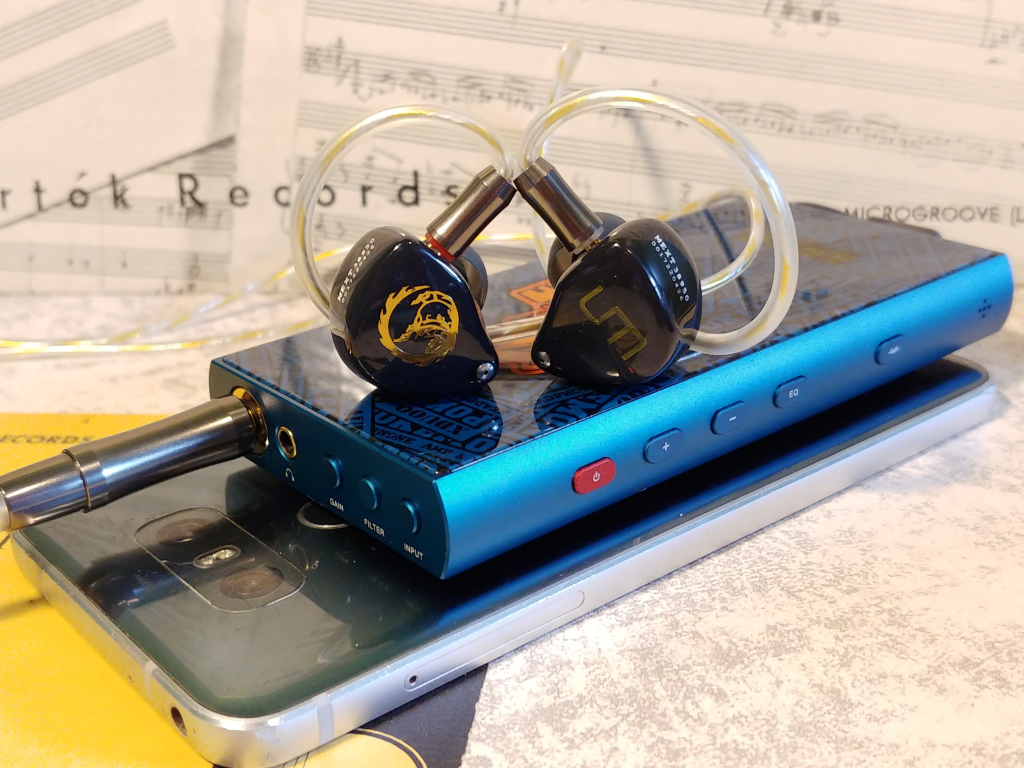
TONALITY
A lean high fidelity neutrality, both smooth and severe in its rendering, with nothing that jumps out at our ears except an incredibly informative resolution, clear and sharp but delicate in its offensive. An emphasis on transparency, on texture, on a more contemplative than immersive realism. It feel like you are seated in the stands of the incredible Maison Symphonique de Montréal concert hall, which has an acoustic architecture that amplifies the clarity of presence, the nuances of timbres, and tends to attenuate the resonances. Because here, tonal balance is flat, it’s without accentuated resonance, it’s without coloration. Tonal purity. Mature high fidelity tonality that magnify more the presence of instrument than their body.
BASS is lean, between dry and organic in timbre and higly resolve in presence with just a hint of mid bass punch and bite. Extension is ultra linear and doesn’t make your IEM or headphones have more rumble at all, much like it tame a bit dynamic impact.
MIDS are ultra crisp and transparent, with plentyfull of thin sounds layers, its centered and a hint restrain in dynamic presence but not in clarity. Cold but realist and smooth, free of sibilance.
TREBLE is the most immersive part and deliver tremendous amount of details richness in a delicate and effortless way. Crisp and airy, with beautifull brilliance and average decay. Its not grainy, and feel the sligth boost might happen after 10khz since highs are what sound the more liverly without feeling imbalance or agressive.
RESOLUTION-ACCURACY
Here is the greatest talent of the POKE II, its resolution is just infinite, literally you can dig the sound layers and find new jewels of details ad infinitum. In fact, it surprises even our “psychoacoustic education”, because here the macro-resolution is as clear as the micro-resolution. Each instrument, each sound seems individually decoded and singular in their presence, without being saturated even if yes the air between the instruments is also…magnify with a texture. Because yes, the textural presence is more emphasized than that of body if we can say so. Like an HD screen that wants to reveal the smallest details of the image without amplified the colors which would risk disconcerting the resolution.
DYNAMIC
From the greatest talent, to the greatest defect to my ears. The dynamics of the Poke II are what will most affect many people’s sense of immersiveness and here it’s restrained, flat and light in weight. The attack seems especially emphatic in the mid low and very high frequencies, and what an iota no more, just the minimum so that it is not a little energetic. The problem is when instruments that must logically deliver differentiated dynamics are on the same sound pressure level so it can feel compressed yet without going distort or messy.
OTHER TECHNICITIES
The Poke II is a master of technicalities, I haven’t tested many DAC-AMPs above $500, but honestly, my ears haven’t heard anything like it. The CS43198 double DACs are flawless here, but perhaps their implementation with current amplification reduces their dynamic range. No matter what you listen to, the POKE II will be able to extract new sound information and restore it naturally, without excitement. Yes, after having listened to more than 50 DAPs and DAC-AMPs, I always say to myself: that’s it! I can’t hear more sound information, I’m done with this cliché sentence: I hear things i’ve never heard in my music before.
And this POKE II arrive and challenges my whole sound perception: how is it possible that I perceive every nuance of texture of this violin bow without it sounding out of place? And what is that behind me, quickly, let’s take off these headphones and look behind! Ah, no…it was a sound coming from the music I listen to. Let’s say that the Poke opens up a new dimension of resolution and sharp precision, and forces you to listen critically without aggression.
Spatiality isn’t what i would call holographic or very open in wideness and tallness, its a bit intimate and centered in the middle with good deepness depending of numbers of sound layers.
Imaging is very good, especially in static instrument placement while layering lack a bit of space between them even if their transparency permit us to dig through them.
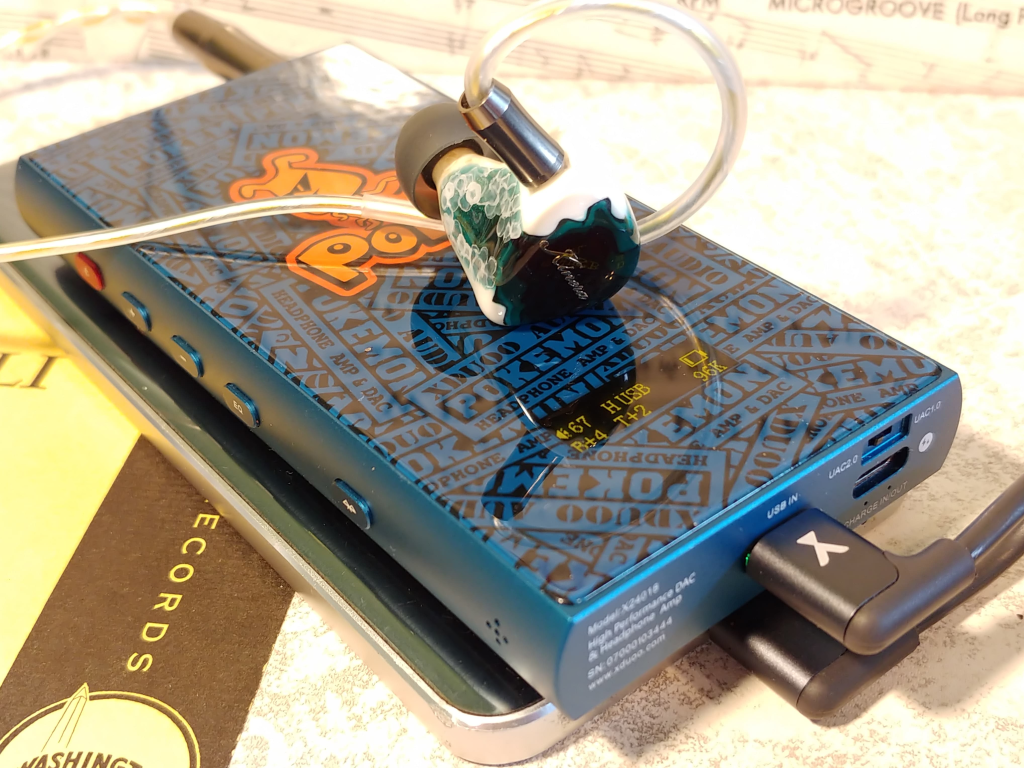
MUSICALITY
This is very subjective, a bit like the appreciation of caresses, but more cerebral. Let’s start by saying that I needed to get used to the sound of the Poke, because it was very different from anything I’ve heard before. Already, this can be seen as a plus, because too often the sound is similar between DAC-AMPs, because the dynamics are more emphasized than the fidelity of music restitution. Yes, for once the elitist term High Fidelity hit me hard with its meaning. Here, I ”watch” the music, contemplate it or analyze it, with an accentuated vision and a diminished corporeality. I am all eyes what. But my sould stay cold. I am an observer, anonymous and perfectionist. Nothing escapes me except the sudden guilty pleasure of emotion. Cold without being completely clinical because gently polished, the Poke II delivers a very niche musicality that will appeal to the most seasoned audiophile, to those who want to hear everything without auditory aggression.
PAIRING
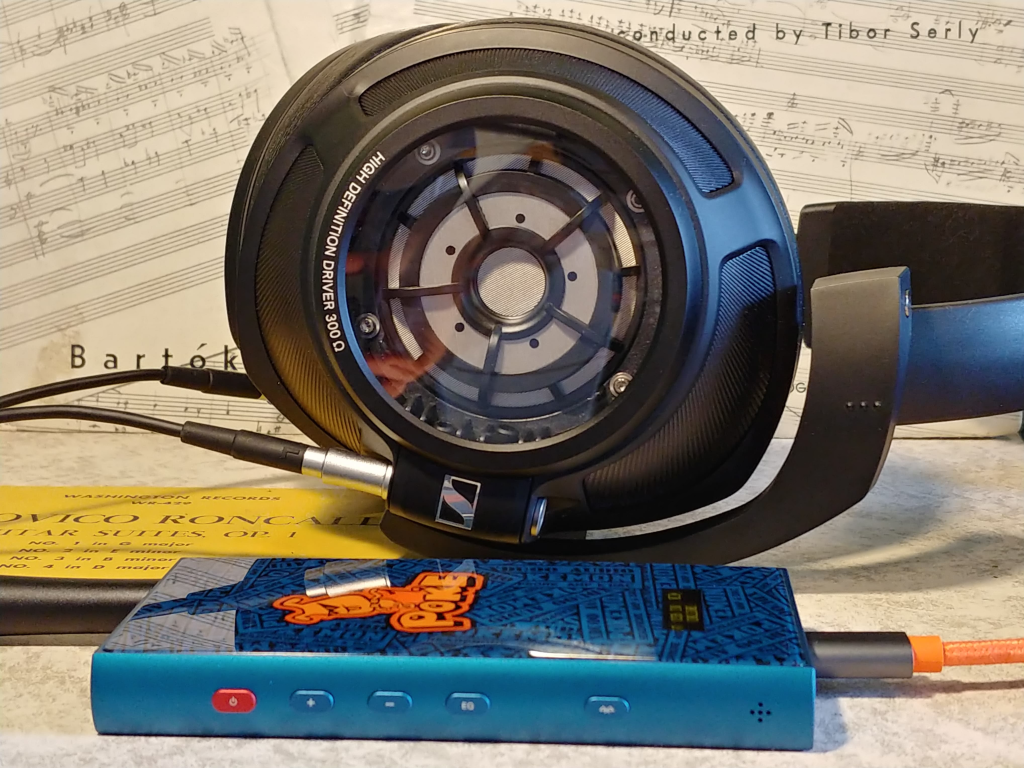
With the UNIQUE MELODY MEXT (crisp bassy balanced L signature), the ultra clean clarity of the Poke II accentuates the precision, the degree of resolution and the control in the attack, all in dynamic delicacy, without too much amplification of any frequency. In fact, MEXTs become lighter in bass strike, which are sharper in definition and less meaty and heavy in impact. The rumble also seems more tenuous and the energy is concentrated in the high frequencies, superbly articulated. If I considered the signature leaning towards a bassy U with certain other sources, here it is neutral with extra high energy, without aggressiveness due to harmonic distortions or sound artifacts. On the other hand, the width of the scene is more compressed, removing in passing the holographic side so addictive of the MEXT.
With the FINAL A8000 (bright W signature) the result is different from the MEXT tribrids, they become more aggressive in a cold and analytical way, the timbre especially seems less dense and natural. The soundstage also undergoes a compression in width and depth, in fact, the sense of depth disappeared with the A8000 as if a saturation of very thin sound layers took place due to the resolving generosity of the Poke II. The bass strike weight is thinner and moves less air. The range of dynamic amplitudes is flattened, making listening less immersive and corpulent.
With the KINERA URD (warm U signature) the complementarity is better, the sub-bass being more amplified, the POKE does not make the resonance and vibrance disappear and in fact improves the separation by reducing the heat of the rendering and accentuating the texture and definition of presence, which with some sources can make the bass very indefinite. In fact, this cocktail is superb, and suddenly reveals the more technical aspect of URDs in terms of resolution, separation and opening of the scene, because here it is vast in width and depth. On the timbre side, like all other headphones, the POKE tend to thin it out and accentuate transparency.
With the SENNHEISER HD820, it’s not bad either and that disconcerts me! Because although the balanced 4.4 output offers 700mw and Poke II promises to be able to correctly feed IEMs or headphones up to 600ohm…I couldn’t believe it. But indeed, the HD820s sound open, clear and detailed and more transparent than ever. Still, the dynamics are lighter, which accentuates the impression of distance from the listener, which is already a bit of a problem with more powerful DAC-AMPs. Still too, the bass impact weakened, which isn’t very heavy or vibrant initially with the HD820s. Let’s say that here we mix two very similar flavors, mature and analytical and without danger of too sudden dynamic amplitude. It’s clean, it’s wise, it’s contemplative, but not intensely enjoyable.
BLUETOOTH CONNECTIVITY & SOUND QUALITY
The Poke II is a Bluetooth 5.0 DAC-AMP receiver, compatible with high resolution codecs such as Ldac and APTX HD. In terms of connectivity stability, I was a little disappointed because the sound tends to cut off when I’m more than 5 meters from the source. I tested with my LG V30 cell phone and Asus Vivobook laptop and the result is the same regardless of the codecs tested (APTX, Ldac, AAC and SBC). It seems more problematic when walls interfere with the signal, but it still isn’t as stable as a Qudelix 5K or Fiio BTR5. I hope Xduoo will solve this problem, which makes the Bluetooth option almost obsolete. Which is more than a shame because the sound is extraordinary, almost 100% similar to its USB version. Very high level of resolution and a relaxed and enveloping musicality. Maybe a little less clean and transparent, but nonetheless excellent and unquestionably superior to Qudelix and Fiio BTR5.COMPARISONS
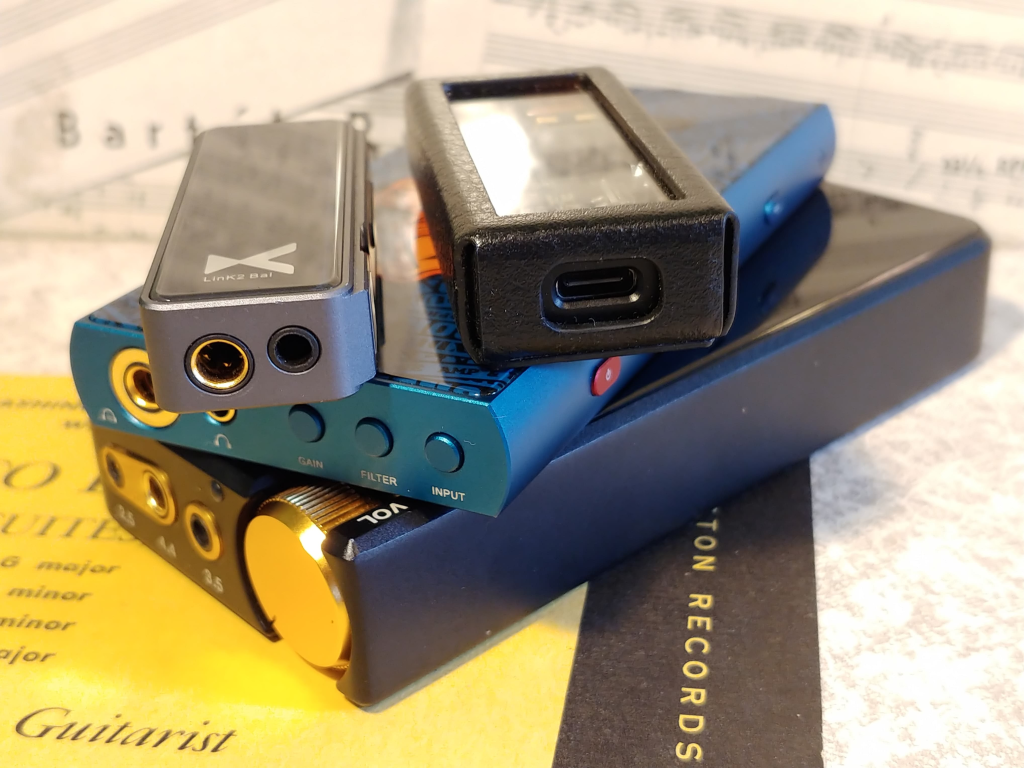
VS XDUOO LINK2 BAL (Dual CS43131 DAC, 270mw@32ohm-160$)
They may come from the same company, my two DAC-AMPs are completely different in sound reproduction. First POKE II is almost three times more powerful on paper, it has a battery so does not drain the phone battery, it can receive Bluetooth too. As for the Link2 Bal, it is notably smaller and less bulky and since its big brother has two audio outputs, a 3.5 SE and a balanced 4.4, its price is almost 3 times smaller too. In terms of sound, the Link2 Bal is more colorful, dense and holographic. More musical and less technical with a thicker and more natural sound timbre but less textured. The resolution is lower but the dynamic more lively, energetic and heavy in impact. Spatiality is less precise but wider and out of the head, making the Poke II’s appear flat, diaphanous and static. In passages of fast and complex music, the Link2 Bal shows its technical inferiority in the synchronicity of attacks which can affect the accuracy of micro-resolutions of definition of each instrument and make them diffuse in their separation. There is no doubt that the Poke II is superior in resolution, attack speed, flawless tonal balance, but its musicality (including sonic timbre) is much more clinical too.
VS TRI TK2 (Dual ES9038q2m, 1250mw@32ohm-280$)
Again very different, but more technically competent than the Link2, so with the TK2 we have the best of both worlds, a high fidelity and ultra powerful DAC-AMP. In fact, almost twice as powerful (1250mw@32ohm) as the Poke II…and much more felt in its dynamic power too. Also, twice as big, which makes it deceptively portable compared to the truly portable Poke II. The price is $100 lower, but it doesn’t have a Bluetooth decoder or gain knob, only a volume wheel. The sound is rounder, fleshier and more charming, with a denser and more natural tone and a heavier, resonant and felted striking force. The transparency is lower as well as the macro-resolution, the lack of air is similar here, the separation lacks space and the contour definition is well cut in space. The basses are rounder and more emphatic in the mid-low impact, with more cut downward extension and less defined upwards. The Poke II has better low frequency separation, which is less warm and more textured, transparent and extended, with that more airy dynamic and light on impact. The medium frequencies are more forward with the TK2, the vocals having more body and largesse in presence. The highs, on the other hand, are more softened, docile and subdued, less sharp and shimmering, offering a lower degree of micro-detail and impressions of slower attacks. Here, the technicalities are similar but more emphasized with the Poke II which still delivers a higher resolution and more efficient musical management.
VS QUESTYLE M15 (ES9281AC, 2.624Vrms-250$)
Another excellent DAC-AMP using current amplification, but this time with an ES9281C saber DAC. Also, without battery and with supposedly lower amplification force although more energetic in its dynamics. Here, the M15 delivers meatier, vibrant and warm bass with more pronounced impact heaviness. The resolution is almost identical, although less finicky in the micro-definition, favoring a roundness of tone denser than the Poke II. In terms of precision and separation, the Poke is an iota superior because it is clearer and cleaner with a more restrained attack in its echo. The M15 has a spatial rendering that has more relief and sculpture of presence, giving a more holographic and open effect in height and width. The spatiality of the Poke is deeper with more static instrumental positioning, more defined and focused in the high frequencies. The flatter, more clinical rendering of the Poke tends to be less immersive and encompassing for the listener than the M15, which despite a technical performance of high resolution and a bit lower micro-details, delivers a more natural, physical and tonally accurate musicality.
CONCLUSION
The Xduoo Poke II offer an extremely high level of resolution that was unheard before in sub-500$ DAC-AMP, with an ultra low distortion and extremely black noise floor. I learn with this DAC-AMP the true meaning of High Fidelity sound restitution and this is when every little details of your music is restitute effortlessly in a lean neutral way that doesn’t sound excited like it often happen with bright sounding DAC-AMP. In fact, it’s so smooth in dynamic that i would not call the Poke II bright nor trebly.Sure, this type of mature crisp tonality might not trigger musicality in everyone mind, but for those out here that are fan of THX amplifier flavor, the Poke II might be their perfect portable companion.
While I consider the Poke II to be a niche Bluetooth portable DAC-AMP, their no doubt it deliver excellent technical performance as well as high amping power for a versatile use.
Only real drawback for me is the Bluetooth connection distance stability, which is a bit short.
When it come to musical appreciation, i do prefer lusher more coloured musicality, but I can see serious audiophile finding their high resolution benchmark with the Poke II.
—–
PS: I wanna thanks Xduoo for sending me this review sample after I share them my appreciation about their Xduoo Link2 Bal dongle.
You can buy the Poke II from this official seller:https://shenzhenaudio.com/products/...d256-portable-ldac-balanced-headphone-amplifi
For more honnest audio review, give a look to my No Borders Audiophile audio blog HERE.
Last edited:
NymPHONOmaniac
@RONJA MESCO yes basically, but im pretty sure it would have paired great with Meze Neo too, but im a bit limited in headphones collection. it isnt a DAC-AMP that inject extra dynamic to your iem or headphones, thats to be noted too.
W
wojtekmarchewka1981
Great description and review. I have a question for an expert on the subject: D. I owned the Xduoo XD-05 for a few years, and it was great, so far. When I bought Monolith M1060c headphones (and made a mod for open) and made a 4.4 mm balanced cable. I thought that the XD-05 Plus (with 2x Op-amp MUSES 03) would give me the expected quality, it turned out to be a mistake, it sounded very much like my worn-out XD-05.
In the meantime, I decided I wanted a DAC / AMP for the Playstation 5 as well, so I bought the Xduoo Link2 Bal. And it really is a great baby, but unfortunately too quiet under the PS5 (no hardware volume control). From what I've read, Poke II has an EQ for gaming mode, and I also have a volume control. Do you think it is worth changing Link2 for Poke2, I would also like more control over what I listen to and, for example, add bass?
In the meantime, I decided I wanted a DAC / AMP for the Playstation 5 as well, so I bought the Xduoo Link2 Bal. And it really is a great baby, but unfortunately too quiet under the PS5 (no hardware volume control). From what I've read, Poke II has an EQ for gaming mode, and I also have a volume control. Do you think it is worth changing Link2 for Poke2, I would also like more control over what I listen to and, for example, add bass?
ExTubeGamer
Did anyone try to connect an amplifier to the Poke 2?
I like to use double amping.
I like to use double amping.


